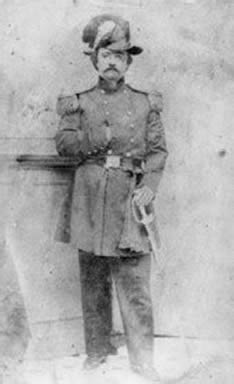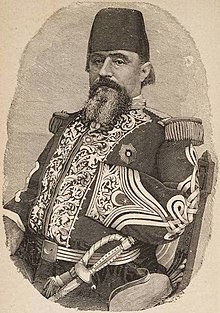
Mission Statement:
"To advance through research, education and symposia, an increased public awareness of the Cape Fear region's unique history."

Major-General William Wing Loring
Wilmington Native and Accomplished Soldier
Cape Fear Historical Institute Papers

Major-General William Wing Loring
General Loring is one of five men calling Wilmington
home who achieved the military rank of general. Of the
five, he, Gen. Smith and Gen. MacRae fought to
defend North Carolina and its political independence.
William Wing Loring
General Loring, born in Wilmington, North Carolina
on December 4, 1818, was an American military officer
who served in the forces of the United States,
Confederate States and Egypt. He was a born
military man who ran off to fight Indians at age fourteen, became a Florida legislator, Indian fighter in the West,
sent by the War Department to study European armies,
fought in the Western Theater of the Civil War, and
afterward, became Pasha Loring organizing the
Egyptian Khedive’s army.
He was the second son born to Reuben and Hannah
Loring, married at Wilmington on May 18, 1812.
William Wing was the fifth grandson of New England
pioneer Deacon Thomas Loring of the original Plymouth Colony. After his fourth birthday in Wilmington, his
family moved to St. Augustine, now located in the Florida Territory acquired from Spain.
At the age of fourteen he began his long military career
fighting Seminoles with the Florida Militia. Three years
later, Loring headed for Texas to join the struggle for independence, but returned when his father came to
retrieve him. He once again went off fighting the
Seminoles, and was soon promoted to second
lieutenant of militia.
He then was sent to boarding school in Virginia and
attended Georgetown College in Virginia for one year,
1839-1840. Returning to Florida, he read law in Judge
Robert R. Reid’s office and was admitted to the bar
in 1842.
A year later Loring was elected to the Florida House
of Representatives, serving 1843-1845, the latter the
year Florida was admitted to the American Union.
In 1845 Loring ran unsuccessfully as a candidate
for Florida’s Senate.
Seeking adventure, Loring joined the US Army’s
newly-formed Regiment of Mounted Rifles in 1846
which was created to protect the Oregon Territory and promoted to the rank of major. Sent shortly afterward
to Texas after war began with Mexico, his regiment
fought in nearly all engagements, and was wounded
three times.
While leading a charge at Mexico City, Loring’s left arm
was shattered, and later amputated. During that conflict
he received two brevet promotions for bravery, one to lieutenant-colonel and the other to the rank of colonel.
Brevet means one attains the insignia and prestige,
but not the pay of the rank.
Remaining in the West, Brevet Col. Loring was ordered in May 1849 to lead a train of civilians and 600 mule teams
the 2000 miles, a five month trek, from Missouri to
Oregon, and take command of the Territory. Arriving
in September, the historic march accomplished what
General Winfield Scott and the War Department
wanted -- the establishment of several trail stations
for later emigrants, protected by cavalry garrisons to
ward off Indian attacks.
Col. Loring’s command at Oregon City lasted for two
years, then was transfered to oversee frontier Forts
Ewell, McIntosh and Union for five years and promoted
to full colonel in December 1856. During this frontier assignment he fought many engagements with Comanches, Apaches and Kiowas – and Mormons in Utah -- and
at the age of only 38, was the youngest colonel in
the US Army.
During this time Col. Loring’s command received 25
camels from Jefferson Davis’ US War Department,
thought to be a logistical answer to the problem of moving supplies over great distances with little
food or water needed.
In 1859 he was selected to study European military tactics with other American officers, especially those employed
during the recent Crimean War. While there he travelled extensively, visiting England, France, Sweden, Prussia, Switzerland, Austria-Hungary, Italy, Russia, Turkey
and Egypt.
In 1861 Colonel Loring was stationed in New Mexico,
and resigning his US Army commission on May 13, 1861.
He told his officers “the South is my home and I am going
to throw up my commission and shall join the Southern
Army, and each of you can do as you think best.”
Offering his services to the Confederate government,
Loring was given command of the Army of the Northwest with the rank of brigadier-general. With this command, General Loring participated in western Virginia’s late
1861 skirmishes, while training new soldiers to meet
the Northern invasion.
At the time, Brigadier-General Loring outranked Robert
E. Lee who was there as an observer from Richmond.
At the battle of Cheat Mountain, Loring acquired the
nickname “Old Blizzards” for the loud cheers to his
men, “Give them blizzards” meaning intense musket firing.
After the unsuccessful attempt to drive the invaders from western Virginia, Gen. Loring and his force joined
Gen. Stonewall Jackson in the Shenandoah Valley.
After a tumultuous relationship with Jackson, Loring was transferred first to southwestern Virginia, then to the West
in October 1862 and under the successive commands of Generals Pemberton, Johnston and Polk. After Gen.
Leonidas Polk was killed near Atlanta in June 1864,
Loring was promoted to command of the Army of
Mississippi and the rank of major-general.
He led his army in the battles of Champion Hill, Jackson, Mississippi, Resaca, Pine Mountain, Kennesaw Mountain, Peachtree Creek, Ezra Church, Franklin, and Nashville.
With the remnants of Hood’s army, Gen. Loring and
his men marched eastward to North Carolina to the
battle of Bentonville, before being surrendered by
Gen. Joe Johnston at Durham.
Egyptian Service
Being out of a military career and no prospects for him in
the United States, Gen. Loring joined about fifty Southern
and Northern veterans recommended to the Ismail Pasha, Khedive of Egypt by Gen. William Sherman. Concerned
about his aggressive neighbors, the Khedive wished to modernize his army and utilize the knowledge of
American officers.
Beginning a nine-year career with the Khedive, Gen. Loring was appointed Inspector General to review the army and
offer recommendations on contemporary strategies,
weapons and equipment. In 1878, former President
Grant toured Egypt and met Gen. Loring at the Great Pyramids, both had not seen each other since the taking
of Mexico City at Garita de Belen where Loring lost an arm.
Initially assigned to coastal defense and fortifications,
Gen. Loring -- then holding the rank of Fereek Pasha,
or major-general -- was named chief of staff to a former
slave of the late Said Pawshar, viceroy of Egypt, who
held negligible military experience. The Egyptian-Ethiopian War ended in disaster with the American advisors blamed
for the defeat. In 1878, the American officers were
dismissed when the Khedive’s European bondholders,
with their own interest in petroleum dominance,
demanded a reduction of the Egyptian army.

For his military service to the Khedive, Gen. Loring was decorated with the Egyptian Orders of Osmanli and Medjidie.
Returning to Florida where he ran unsuccessfully for the
US Senate, Gen. Loring moved to New York City to work
on his autobiography, “A Confederate Soldier in Egypt,” published in 1884.
He died on December 30, 1886, with Charles Chaille-Long, his aide-de-camp in Egypt, at his side.
Gen. Loring's ashes were interred at Grace Episcopal Church in New York City, Rev. Dr. William Reed Huntington officiating. Gen. Loring’s obituary made headlines across
the country.
A lifelong bachelor, Gen. Loring never married.
Searching for a Final Resting Place
It was not long before a committee was formed to
bring Gen. Loring home to his adopted home of
St. Augustine. His remains were brought to the city for
burial at Woodland Cemetery, and on March 19, 1887,
the Florida Times-Union of Jacksonville reported the
activities of the previous day:
“One of the most striking features of the parade was
the fraternizing of the veterans of both armies.
The Jacksonville Post of the Grand Army of the Republic went to St. Augustine as the guests of the Jacksonville
Camp of Confederate Veterans. After arriving they were joined by a number of other veterans, and at an impromptu meeting . . . it was decided that instead of maintaining separate organizations, they should march in the
procession with the Confederates and the Federals,
two and two, arm in arm . . . It was a genuine union of the Blue and the Gray, and was accepted as a symbol of
a reunited people. It was felt, too, to be peculiarly appropriate that such a fraternization should occur at
the grave of General Loring – who had been a soldier
of the [Northern] Republic as well as the
[Confederate Republic].”
The General’s longtime friend from the battles of 1861
and 1862, Rev. Dr. Charles Todd, read the Episcopal
burial service. While this was read, an officer unsheathed
and broke one of Gen. Loring’s swords, casting all into
the grave. A final artillery and musket salute was fired
by the assembled cadets.
In 1920, the Anna Dummett Chapter of the Daughters of
the Confederacy and the Gen. Loring Chapter of the
Children of the Confederacy, both of St. Augustine,
began their campaign to establish a downtown memorial
to Gen. Loring. The plot at the corner of Cordova and
King Streets, formerly known as Post Office Square,
was acquired from the federal government with private
funds raised by those organizations.
On July 6, 1920, Gen. Loring’s remains were placed
beneath the site, now designated as the garden of the Government House. A week later a tall obelisk was
erected above his remains, and dedicated on
December 30th.
Sources:
W.W. Loring, Florida’s Forgotten General, James W. Raab, Sunflower University Press, 1996.
WIKI, accessed 8.22.20
©2006 Cape Fear Historical Institute